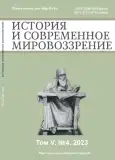Agricultural Taxation of Ural Individual Farmers at the Final Stage of Collectivization
- Autores: Filatov V.V.1
-
Afiliações:
- Nosov Magnitogorsk State Technical University
- Edição: Volume 5, Nº 4 (2023)
- Páginas: 52-63
- Seção: ECONOMIC HISTORY
- URL: https://journals.rcsi.science/2658-4654/article/view/252181
- DOI: https://doi.org/10.33693/2658-4654-2023-5-4-52-63
- EDN: https://elibrary.ru/SCJOPI
- ID: 252181
Citar
Resumo
The problem of taxation of peasants during the years of collectivization still remains relevant for researchers. Scientists in the field of historical, economic and legal sciences turn to the study of certain aspects of the tax policy of the Soviet government in the 1930s. However, there is still not enough research on this problem covering the largest regions of the country, such as the Greater Urals. The conclusions obtained as a result of the study allow us to identify the peculiarities of taxation of the Ural peasantry. The author continued a series of articles devoted to the implementation of the agricultural tax in the Urals, but within new administrative-territorial boundaries from 1934 to the early 1940s. The purpose of studying the problem is to identify, on the basis of historical and legal analysis, the features of the implementation of tax legislation in the Urals. The object of study was the individual peasantry. The use of both general scientific and historical methods (comparative, statistical, historical-genetic and others) made it possible to solve the problems. The scientific novelty of the research was manifested in the use of new documentary material, the development of a dynamic table, and the systematization of data from various sources. The analysis confirmed the hypothesis about non-economic methods of influencing the farms of individual farmers, which in the pre-war years led to their virtual disappearance from the economic life of the village. The agricultural tax, coupled with other cash payments and natural food compulsory deliveries, forced individual farmers to join a collective farm or migrate to the city, move to state farms and other production structures.
Palavras-chave
Texto integral
##article.viewOnOriginalSite##Sobre autores
Vladimir Filatov
Nosov Magnitogorsk State Technical University
Autor responsável pela correspondência
Email: v.philatov@mail.ru
ORCID ID: 0000-0003-3076-2324
Dr. Sci. (Hist.), Associate Professor, Leading Researcher at the Research Institute of Historical Anthropology and Philology
Rússia, MagnitogorskBibliografia
- Beznin M. A., Dimoni T. M. Duties of Russian collective farmers in the 1930–1960s // Domestic History. 2002. No. 2. pp. 96–111.]
- Vyltsan M. A. The last individual farmers. Source base, historiography // The fate of the Russian peasantry. M.: Russian State University for the Humanities. 1995, pp. 364–387.
- Denisevich M. N. Individual farms in the Urals (1930–1985). Ekaterinburg: Institute of History and Archeology Ural. Department of the USSR Academy of Sciences, 1991. 195 p.
- Zelenin I. E. Collectivization and the individual owner (1933 — first half of 1935) // Domestic history. 1993. No. 3. pp. 35–55.
- Ilyinykh V. A. Taxation of the Siberian village: the end of the 1920s — the beginning of the 1950s. Novosibirsk: State Unitary Enterprise RPO SO RAASKHN, 2004. 167 p.
- Kornilov G. E. Ural village during the Great Patriotic War (1941–1945). Sverdlovsk: Ural University Publishing House, 1990. 224 p.
- Kornilov G. E. Ural village and war (problems of demographic development). Ekaterinburg: Uralagropress, 1993. 174 p.
- Kuznetsov N. S. From the darkness... Izhevsk: Udm Publishing House. Univ., 1994. 494 р.
- Maryakhin G.L. Essays on the history of taxes from the population in the USSR. M.: Finance, 1964. 252 p.
- Motrevich V.P. Contribution to the Victory: agriculture of the Urals during the Great Patriotic War: monograph. Ekaterinburg: LLC Universal Printing House «Alpha Print», 2021. 700 p.
- Motrevich V.P. Collective farms of the Urals during the Great Patriotic War. Sverdlovsk: Ural Publishing House. Univ., 1990. 195 p.
- Popov V.P. Peasant taxes in the 40s // Sociological studies. 1997. No. 2. pp. 95–114.
- Filatov V.V. Preferences in the implementation of agricultural tax in the Urals in the early 1930s // History and modern world view. 2023. T. 5. No. 1. P. 34–47.
- Filatov V.V. Agricultural tax in the Urals on the eve of mass collectivization // Questions of history. 2017. No. 6. pp. 53-69.
- Filatov V.V. Ural village, 1927-1941: dynamics and rates of development of livestock farming: Monograph. Magnitogorsk: State Educational Institution of Higher Professional Education «MSTU», 2006. 264 р.
- Fitzpatrick S. Stalin’s peasants. Social history of Soviet Russia in the 30s: village. M.: ROSSPEN, 2001. 422 p.
- Khisamutdinova R. R. Agriculture of the Urals during the Great Patriotic War. Little-known pages. Orenburg: OGPU Publishing House, 2002. 300 p.
- Tsyganov V. B. Formation of an administrative-command system for managing collective farms in the Urals (1933 — June 1941). Sverdlovsk: Ural Publishing House. University, 1991.
Arquivos suplementares








